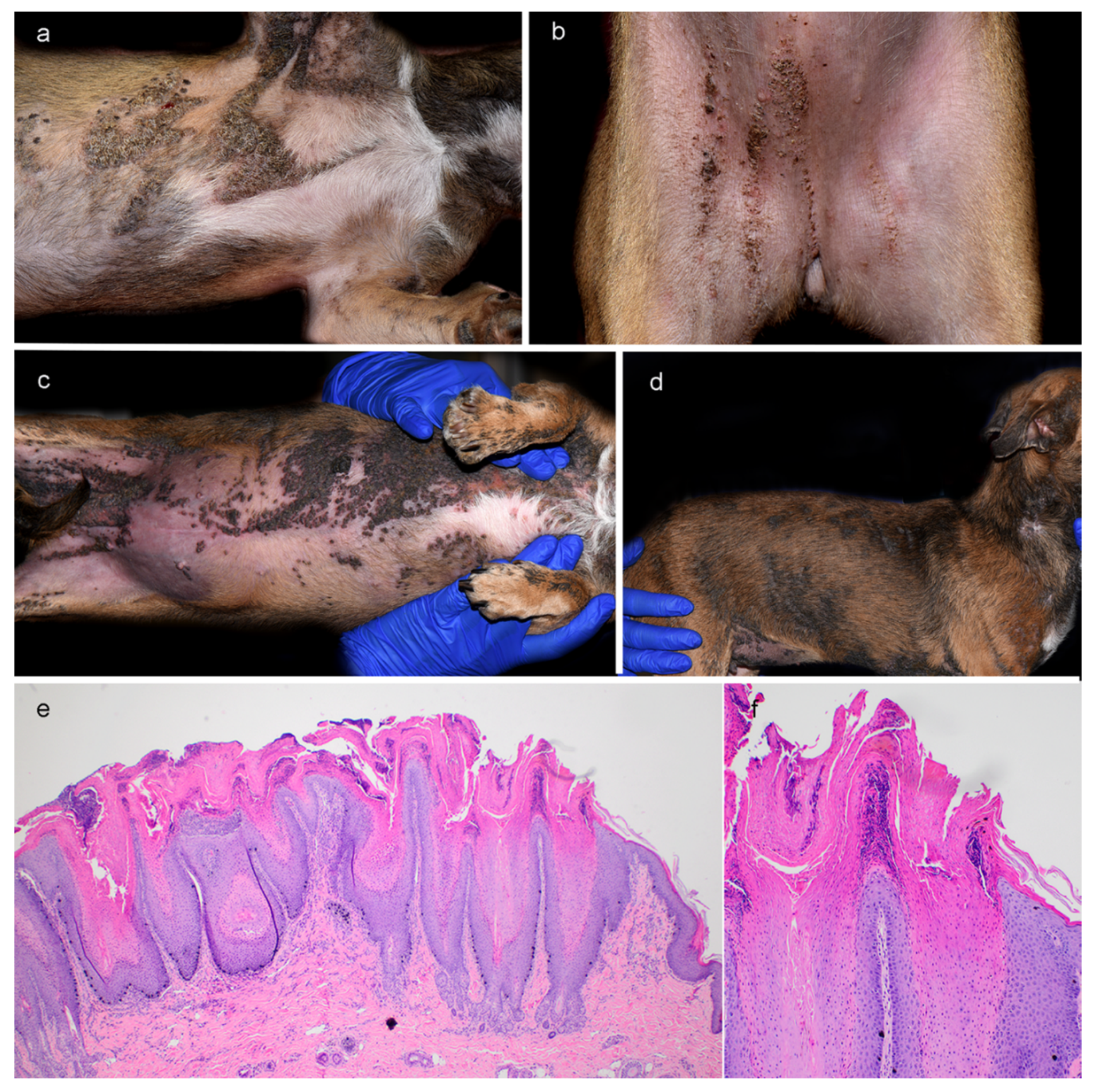NSDHL Frameshift Deletion in a Mixed Breed Dog with Progressive Epidermal Nevi
Abstract
1. Introduction
2. Materials and Methods
2.1. Ethics Statement
2.2. Animal Selection
2.3. DNA and RNA Extraction
2.4. Gene Analysis
2.5. PCR and Sanger Sequencing
3. Results
3.1. Clinical Examination, Necropsy, and Histopathology
3.2. Genetic Analysis
4. Discussion
5. Conclusions
Supplementary Materials
Author Contributions
Funding
Acknowledgments
Conflicts of Interest
References
- Happle, R.; Koch, H.; Lenz, W. The CHILD syndrome. Congenital hemidysplasia with ichthyosiform erythroderma and limb defects. Eur. J. Pediatr. 1980, 134, 27–33. [Google Scholar] [CrossRef]
- Happle, R.; Mittag, H.; Küster, W. The CHILD nevus: A distinct skin disorder. Dermatology 1995, 191, 210–216. [Google Scholar] [CrossRef] [PubMed]
- Bornholdt, D.; König, A.; Happle, R.; Leveleki, L.; Bittar, M.; Danarti, R.; Vahlquist, A.; Tilgen, W.; Reinhold, U.; Poiares Baptista, A.; et al. Mutational spectrum of NSDHL in CHILD syndrome. J. Med. Genet. 2005, 42, e17. [Google Scholar] [CrossRef] [PubMed]
- Avgerinou, G.P.; Asvesti, A.P.; Katsambas, A.D.; Nikolaou, V.A.; Christofidou, E.C.; Grzeschik, K.H.; Happle, R. CHILD syndrome: The NSDHL gene and its role in CHILD syndrome, a rare hereditary disorder. J. Eur. Acad. Dermatol. Venereol. 2010, 24, 733–736. [Google Scholar] [CrossRef] [PubMed]
- Garcias-Ladaria, J.; Cuadrado Rosón, M.; Pascual-López, M. Epidermal Nevi and Related Syndromes—Part 1: Keratinocytic Nevi. Actas Dermosifiliogr. 2018, 109, 677–686. [Google Scholar] [CrossRef] [PubMed]
- Bittar, M.; Happle, R.; Grzeschik, K.-H.; Leveleki, L.; Hertl, M.; Bornholdt, D.; König, A. CHILD syndrome in 3 generations. Arch. Dermatol. 2006, 142, 7–10. [Google Scholar] [CrossRef] [PubMed]
- Happle, R. X-chromosome inactivation: Role in skin disease expression. Acta Paediatr. Suppl. 2006, 95, 16–23. [Google Scholar] [CrossRef]
- König, A.; Happle, R.; Bornholdt, D.; Engel, H.; Grzeschik, K.H. Mutations in the NSDHL gene, encoding a 3β-hydroxysteroid dehydrogenase, cause CHILD syndrome. Am. J. Med. Genet. 2000, 90, 339–346. [Google Scholar] [CrossRef]
- Liu, X.Y.; Dangel, A.W.; Kelley, R.I.; Zhao, W.; Denny, P.; Botcherby, M.; Cattanach, B.; Peters, J.; Hunsicker, P.R.; Mallon, A.M.; et al. The gene mutated in bare patches and striated mice encodes a novel 3β-hydroxysteroid dehydrogenase. Nat. Genet. 1999, 22, 182–187. [Google Scholar] [CrossRef]
- Bauer, A.; De Lucia, M.; Jagannathan, V.; Mezzalira, G.; Casal, M.L.; Welle, M.M.; Leeb, T. A large deletion in the NSDHL gene in Labrador Retrievers with a congenital cornification disorder. G3 Genes Genomes Genet. 2017, 7, 3115–3121. [Google Scholar] [CrossRef][Green Version]
- Leuthard, F.; Lehner, G.; Jagannathan, V.; Leeb, T.; Welle, M. A missense variant in the NSDHL gene in a Chihuahua with a congenital cornification disorder resembling inflammatory linear verrucous epidermal nevi. Anim. Genet. 2019, 50, 768–771. [Google Scholar] [CrossRef]
- De Lucia, M.; Bauer, A.; Spycher, M.; Jagannathan, V.; Romano, E.; Welle, M.; Leeb, T. Genetic variant in the NSDHL gene in a cat with multiple congenital lesions resembling inflammatory linear verrucous epidermal nevi. Vet. Dermatol. 2019, 30, 64-e18. [Google Scholar] [CrossRef]
- Caldas, H.; Herman, G.E. NSDHL, an enzyme involved in cholesterol biosynthesis, traffics through the Golgi and accumulates on ER membranes and on the surface of lipid droplets. Hum. Mol. Genet. 2003, 12, 2981–2991. [Google Scholar] [CrossRef]
- Zettersten, E.; Man, M.Q.; Sato, J.; Denda, M.; Farrell, A.; Ghadially, R.; Williams, M.L.; Feingold, K.R.; Elias, P.M. Recessive x-linked ichthyosis: Role of cholesterol-sulfate accumulation in the barrier abnormality. J. Investig. Dermatol. 1998, 111, 784–790. [Google Scholar] [CrossRef] [PubMed]
- Elias, P.M.; Williams, M.L.; Holleran, W.M.; Jiang, Y.J.; Schmuth, M. Pathogenesis of permeability barrier abnormalities in the ichthyoses: Inherited disorders of lipid metabolism. J. Lipid Res. 2008, 49, 697–714. [Google Scholar] [CrossRef]
- Elias, P.M.; Crumrine, D.; Paller, A.; Rodriguez-Martin, M.; Williams, M.L. Pathogenesis of the cutaneous phenotype in inherited disorders of cholesterol metabolism: Therapeutic implications for topical treatment of these disorders. Dermatoendocrinology 2011, 3, 100–106. [Google Scholar] [CrossRef]
- Seeger, M.A.; Paller, A.S. The role of abnormalities in the distal pathway of cholesterol synthesis in the Congenital Hemidysplasia with Ichthyosiform erythroderma and Limb Defects (CHILD) syndrome. Biochim. Biophys. Acta Mol. Cell Biol. Lipids 2014, 1841, 345–352. [Google Scholar] [CrossRef] [PubMed]
- Alexopoulos, A.; Kakourou, T. CHILD syndrome: Successful treatment of skin lesions with topical simvastatin/cholesterol ointment—A case report. Pediatr. Dermatol. 2015, 32, e145–e147. [Google Scholar] [CrossRef]
- Cho, S.K.; Ashworth, L.D.; Goldman, S. Topical cholesterol/simvastatin gel for the treatment of CHILD syndrome in an adolescent. Int. J. Pharm. Compd. 2020, 24, 367–369. [Google Scholar] [PubMed]
- Jagannathan, V.; Drögemüller, C.; Leeb, T.; Aguirre, G.; André, C.; Bannasch, D.; Becker, D.; Davis, B.; Ekenstedt, K.; Faller, K.; et al. A comprehensive biomedical variant catalogue based on whole genome sequences of 582 dogs and eight wolves. Anim. Genet. 2019, 50, 695–704. [Google Scholar] [CrossRef] [PubMed]
- Richards, S.; Aziz, N.; Bale, S.; Bick, D.; Das, S.; Gastier-Foster, J.; Grody, W.W.; Hegde, M.; Lyon, E.; Spector, E.; et al. Standards and guidelines for the interpretation of sequence variants: A joint consensus recommendation of the American College of Medical Genetics and Genomics and the Association for Molecular Pathology. Genet. Med. 2015, 17, 405–424. [Google Scholar] [CrossRef] [PubMed]


Publisher’s Note: MDPI stays neutral with regard to jurisdictional claims in published maps and institutional affiliations. |
© 2020 by the authors. Licensee MDPI, Basel, Switzerland. This article is an open access article distributed under the terms and conditions of the Creative Commons Attribution (CC BY) license (http://creativecommons.org/licenses/by/4.0/).
Share and Cite
Christen, M.; Austel, M.; Banovic, F.; Jagannathan, V.; Leeb, T. NSDHL Frameshift Deletion in a Mixed Breed Dog with Progressive Epidermal Nevi. Genes 2020, 11, 1297. https://doi.org/10.3390/genes11111297
Christen M, Austel M, Banovic F, Jagannathan V, Leeb T. NSDHL Frameshift Deletion in a Mixed Breed Dog with Progressive Epidermal Nevi. Genes. 2020; 11(11):1297. https://doi.org/10.3390/genes11111297
Chicago/Turabian StyleChristen, Matthias, Michaela Austel, Frane Banovic, Vidhya Jagannathan, and Tosso Leeb. 2020. "NSDHL Frameshift Deletion in a Mixed Breed Dog with Progressive Epidermal Nevi" Genes 11, no. 11: 1297. https://doi.org/10.3390/genes11111297
APA StyleChristen, M., Austel, M., Banovic, F., Jagannathan, V., & Leeb, T. (2020). NSDHL Frameshift Deletion in a Mixed Breed Dog with Progressive Epidermal Nevi. Genes, 11(11), 1297. https://doi.org/10.3390/genes11111297





